Continuing Swiss Week, we have more detailed information on the LMG25 light machine gun today. There design was officially adopted by the Swiss Army in 1925 (as you might have guessed) after about 7 years of development under the direction of Adolf Furrer at Waffenfabrik in Bern, and was not taken fully out of service until the 1970s. As best we can tell, it was a reasonably reliably gun – at least enough so to remain the main Swiss light machine gun throughout World War II. The guns were manufactured from 1924 until 1946, with about 23,000 made in total. There are a couple uncommon variants, including a cavalry model with a folding butt and some made during WW2 with rails for mounting optical sights. It is chambered for the standard Swiss 7.5x55mm cartridge, and uses 30-round box magazines mounted on the left side of the receiver.
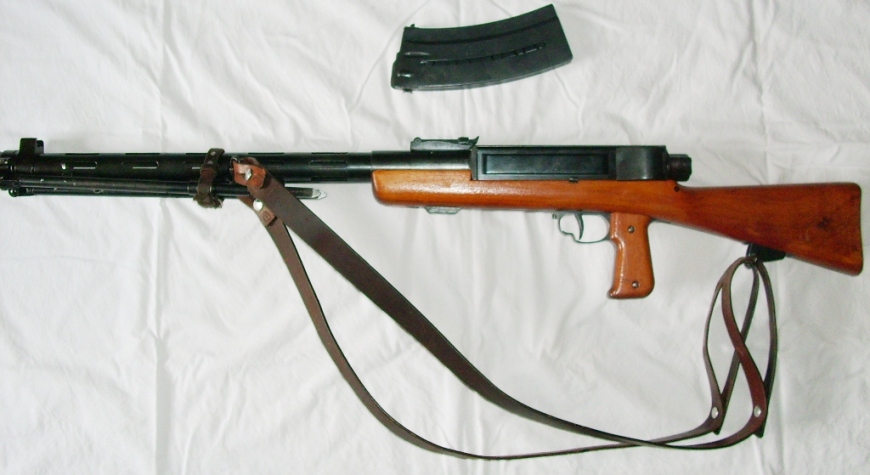
Mechanically, the LMG25 is recoil operated and toggle locked, although it is a bit different than most other toggle locked designs. Upon firing, the barrel, barrel extension, and bolt assembly all move backwards a short distance, and a cam on the inside of the receiver forces the toggle joint to break, unlocking the action. At this point in most guns, the barrel would stop and the bolt would continue rearward under intertia, but the LMG25 is different. The barrel and bolt parts remain connected at all times – so the barrel continues recoiling backwards under the bolt is fully open. The geometry of the toggle lock legs is such that the bolt is accelerated open faster than the barrel moves backwards, allowing the empty case to clear the chamber and eject. At the end of travel, a recoil spring in the rear pushes the whole assembly forward, forcing the bolt shut again and chambering a new cartridge.
This twist on the recoil operating mechanism helps improve the reliability of the gun by having the momentum of the whole barrel driving the extraction and ejection all the way back. In most short recoil actions, dirt can stop the system once the barrel finishes moving because the mass of the bolt alone is much less, and thus more easily stopped by friction.
I should also note that the LMG25 fires from an open bolt, so when the trigger is released the action will stop fully open. The selector lever is (unusually) located on top of the magazine well, with settings fro safe, semiautomatic, and fully automatic fire.
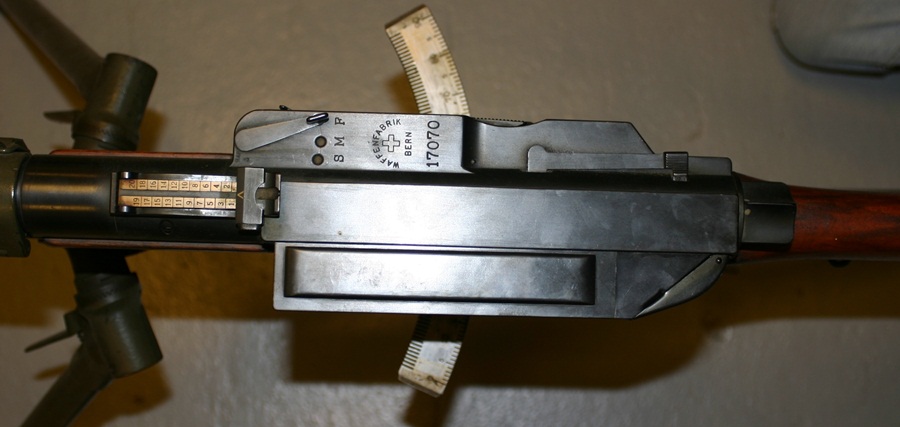
The gun is thoughtfully equipped with covers for all openings, to help keep it clean when not firing. Because the bolt assembly extends way out both sides of the receiver when open, the cutout for the ejection port is much larger than on other light machine guns. It is protected by a two-part cover, which has to be closed manually but opens automatically when the bolt handle is operated:
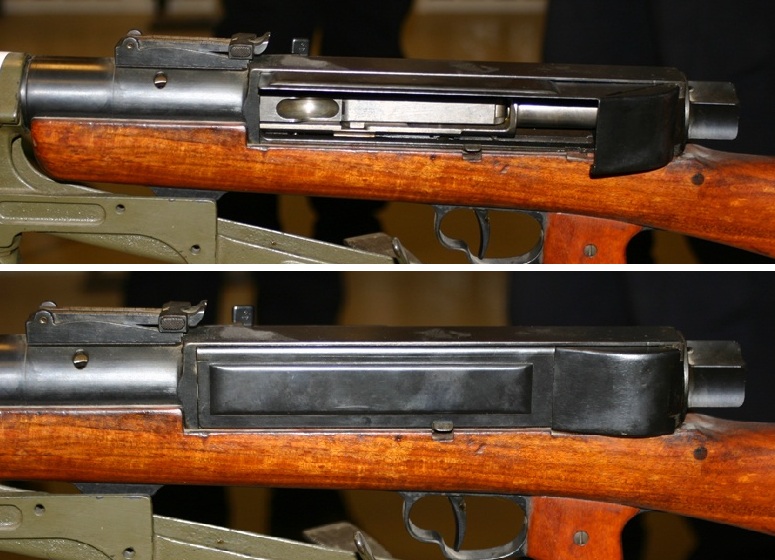
Disassembly is very simple. There is a large nut at the back of the receiver that can be removed by hand. The recoil spring comes out after that nut is removed, and then the whole barrel and bolt assembly slides out the back. At that point the gun is field stripped. The most common machine gun problems – such as a broken extractor or firing pin – can be dealt with by simply replacing the whole assembly until you have the time to replace small parts or leave the broken assembly with a unit armorer (not that I expect parts breakage would be an issue with the LMG25).
Interestingly, the rear monopod supplied for the gun (a common idea at the time, to allow reasonably stable fire for an emplaced gun without the need for a bulky tripod), couple also be attached to the handguard out front for use a vertical grip for assault fire:
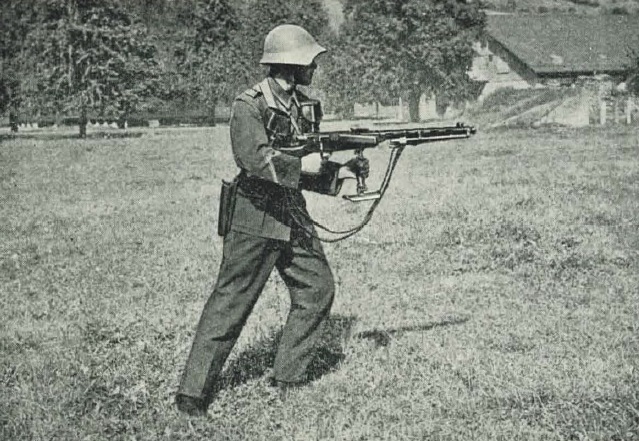
Having mentioned the folding-stock cavalry version up above, I should take a moment to elaborate. We normally think of a folding stock moving 180 degrees, so it is flat against the side or bottom of the stock for more compact transport. Well, the LMG25 folding stock is a bit different. It was designed to fit a cavalry scabbard, so instead of fully folding, the buttstock only goes 90 degrees, dropping down parallel to the pistol grip:
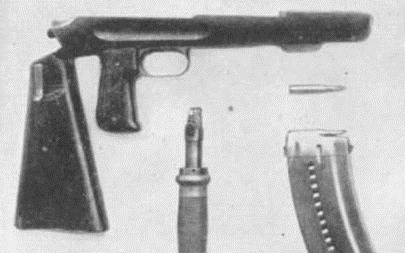
Videos
In case you’re wondering, that LMG25 was live and fully functional, and priced at 1950 Euros (about $2800) – mere pocket change compared to machine gun prices here. It’s not too difficult to get the permit to own it in Belgium, but sadly there is no legal way to bring it into the US.
In addition, we found a small video of someone else (not us, unfortunately) shooting an LMG-25. I tried to download a copy and put it on YouTube, but my tech skills aren’t quite up to the task – so you’ll have to go over to ImageShack to see it: LMG25 firing.
Photos
This is the LMG25 we found for sale at Cornet & Co (click here to download the high-res gallery)
Manuals
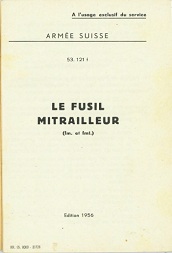
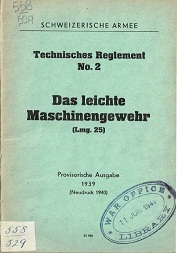











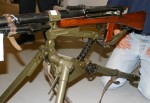



















Fascinating. A very impressive LMG, with the exception of those surprising open slots in the sides of magazines.
Hi thanks for the review. I’m interested because my Granddad was guarding the Swiss German Border during ww2 with the LMG! He was one of the first Grenadiers of the Swiss Army chosen because he was almost 6 feet! Regards Felix
I know this is an old post but I couldn’t help but notice an error in describing the operation. There is no cam in this action. It is what makes this toggle action so much different from the Luger and some of the others. The toggle is broken open by a link tied to the receiver rather than by a cam. For the entire travel of the system the toggle is under mechanical control and tied directly to the motion of the recoiling barrel. As noted in your article this adds the inertia of the barrel to the mix which increases the reliability. It also insures that the toggle is always in the correct position for the operation being done. Ejection and loading are much more precisely controlled and the travel of the system is much shorter than most machineguns or semi autos. It takes time getting used to the short throw on the cocking handle.
Timmie